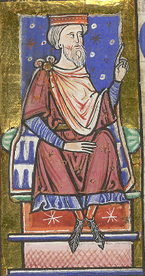Kenneth IV of Scotland
| Kenneth IV | |
|---|---|
 Kenneth depicted in the 13th century | |
| King of Scots | |
| Reign | 26 July 1146 - 10 October 1159 |
| Predecessor | Lulach II |
| Successor | Hugh |
| Born | 1084 Scotland |
| Died | 10 October 1159 (aged 75) Forteviot, Scotland |
| Burial | Scone Abbey |
| Consort | Klementia, duchess of Flanders (m. 1105; d. 1118) Cecelia, queen of Egypt (m. 1121; d. 1141) |
| Issue | Richard, duke of Flanders Gilchrist of Connaught Magnus, earl of Atholl Duncan Kenneth, duke of Cairo William |
| House | of Moray |
| Father | Malsnectan |
| Mother | Cecelia of Normandy |
Kenneth IV, known as Kenneth the Holy (1084 - 10 October 1159) reigned as King of Scots from 1146 until his death. Chosen to succeed his eldest brother Lulach the Bold after a long and varied career, Kenneth campaigned vigorously against the kingdom of Mercia, seeking to subject it to Scottish rule, but was ultimately unsuccessful. His reputation for piety was well-known to contemporaries and has endured after his death, resulting in his byname.
Life and career
Kenneth was born in 1084, the fifth and youngest child of Malsnectan, king of Scots, and Cecelia of Normandy. Nothing is known of Kenneth's childhood or early years, but he seems to have displayed martial prowess since his youth; he was noted by a later chronicler as "standing tall and strong among the sons of men", while the Norman knightly traditions of his mother's family were a strong influence on the Scottish court at that time.
Kenneth may have accompanied his father and three brothers during the Scottish invasion of England in 1097-98. Several chroniclers report that he joined his eldest brother Lulach in the murder of the French prince Eudes de Bourgogne in 1102, shortly before the death of his mother Queen Cecelia.
Flemish career
In 1105, aged twenty-one, Kenneth married Klementia von Wittelsbach, duchess of Flanders, in a marriage arranged by his father. Little is known of Kenneth's time as duke of Flanders jure uxoris, but he seems to have enjoyed a happy union with Klementia until the duchess died on 4 February 1118.
Kenneth returned to Scotland later that year as ambassador for his eldest son Richard, the new duke of Flanders. During the winter of 1118-19, after the outbreak of rebellion against Richard, Kenneth was sent back by his father with a fleet of sixteen ships and a small army to restore order in the duchy. In February 1119 Kenneth led these Scots to capture the castle of Beaumont, held against his son by the rebel Reinoud de Guines. Shortly afterwards, however, the rebels gained the upper hand and Kenneth was forced to return to Scotland to ask for more aid. Kenneth finally sailed for Flanders in 1121 with thousands of reinforcements, and Richard's authority was restored the following year.
Egyptian career
In 1121 or 1122 Kenneth contracted a second marriage with his niece Cecelia, daughter and heiress of his elder brother William, crusader king of Egypt. The marriage seems to have been at William's suggestion to strengthen the House of Moray's hold on Egypt against Sunni unrest; by this point, in his late thirties, Kenneth already enjoyed a reputation as a fearsome warrior. Kenneth seems to have traveled east sometime in 1122 after marrying Cecelia by proxy, but William's death in 1123 vaulted the duo of uncle and niece onto the Egyptian throne more quickly than expected.
Almost immediately Cecelia's rule in Egypt was shaken by widespread Sunni rebellions under the Salavid dynasty. A brutal war ensued, with Kenneth leading his niece's armies in battle, until the Salavids claimed the restoration of the old sultanate and the end of the Christian kingdom in 1126. Cecelia was allowed by the new Sunni rulers to retain the dignity of "duchess of Cairo" until her death, and her union with Kenneth produced three sons, despite protestations from Rome over the deeply incestuous nature of their union. Kenneth seems to have left Egypt some time around 1138, shortly after the birth of their last child. Cecelia died on 18 May 1141, at which point their eldest son Kenneth was recognized as duke of Cairo.
Road to the throne
Kenneth's return to Scotland at the end of the 1130s was fortuitous. In May 1139 his nephew Ragnall, duke of Mann, the heir to the Scottish throne, was assassinated in Linlithgow, raising the question of who would succeed Lulach II on his death. The principal candidates who emerged were Ragnall's eldest son Constantine, the king's eldest surviving son Hugh, and Kenneth himself, who had the weakest claim based on lineal right but who was the only experienced warrior and administrator among the three men. In August 1139, King Lulach nominated Kenneth, then aged fifty-five, as his immediate heir, as a political compromise by which Kenneth would reign for a short time and be succeeded as king by Hugh. In 1144 the nobility were required to renew their oaths to Kenneth at an assembly at Dunblane.
Reign (1146-59)
Lulach II died at St. Andrews on 26 July 1146, leaving Kenneth as the rightful heir as per the succession arrangements of 1139 and 1144. On 29 July Kenneth was inaugurated as king at Scone at the remarkable age of sixty-two; few Scotsmen expected that their new king would live long. Immediately upon his inauguration, Kenneth nominated Hugh as his heir as per his deceased brother's wishes.